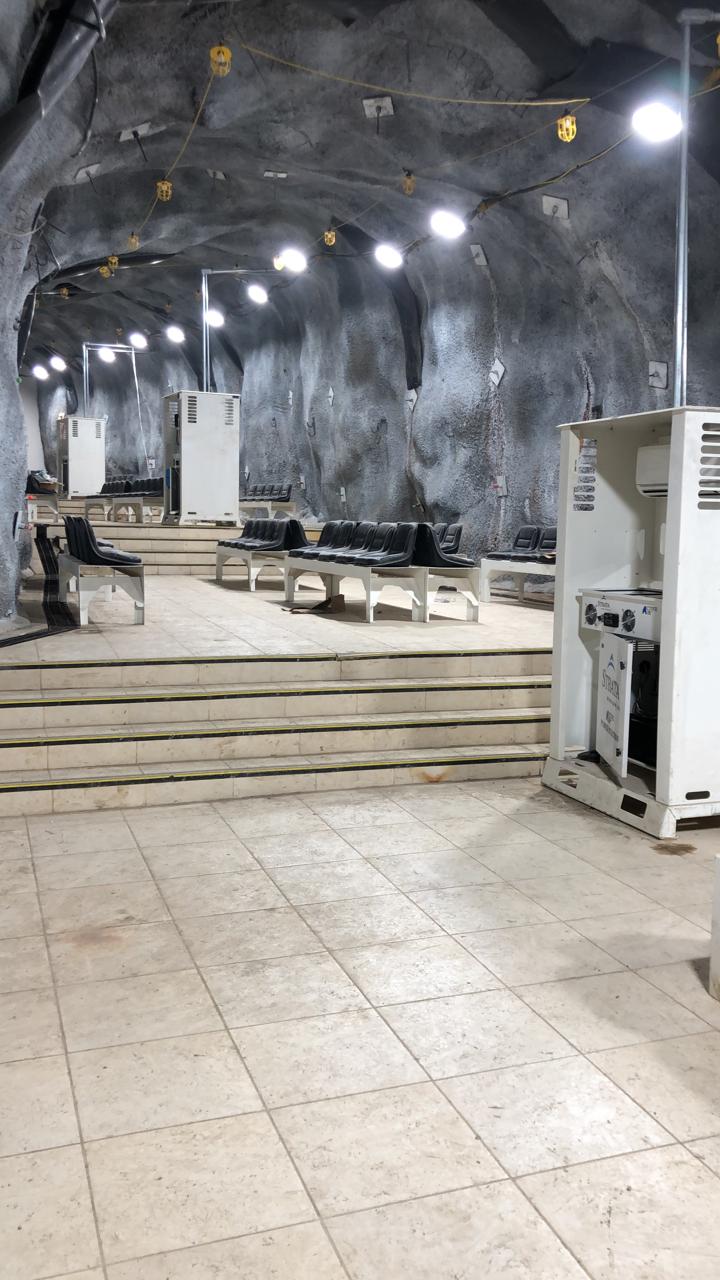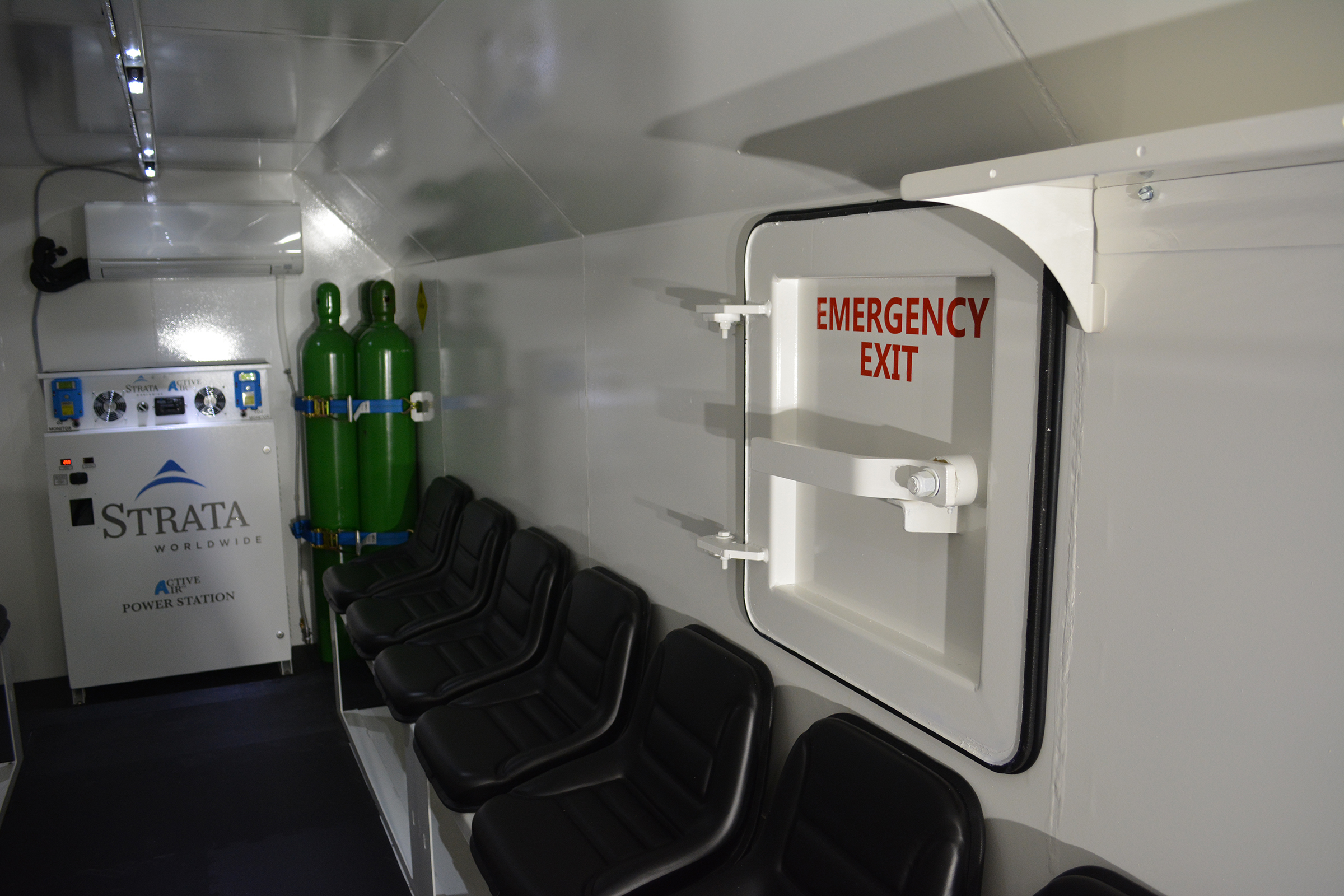Refuge chambers may not have been part of the underground safety view as little as two decades ago, but today they are commonplace – even if the regulatory outlines for their use still vary by location. NAM talked with Strata Worldwide about the aspects of these units that are shared (and vastly different) between the U.S. and other mining regions of the world.
By Donna Schmidt
The roundtable of refuge chamber experts included U.S. general manager David Maust as well as Strata South Africa chamber product manager Tom Long and Latin America technical service manager Omar Rodriguez. The group shared that regulations and common uses in hard rock mining specifically are as vast as the mines the go into.
The primary purpose of refuge shelters is to provide fresh breathable air to people in an emergency situation. Incidents in mining often cause air contamination and workers need to be isolated from toxic gases in the atmosphere. Shelters are designed to provide breathable air in an air-tight environment for a specific period of time.

Do all mines have an external air hook up, or do some only use onboard air supply?
In most hard rock mines, according to Maust, operations have external compressed air lines, and they use this source of air to their chambers.
In Mexico, Rodriguez added, approximately 95% of mines have a connection to a compressed air supply, and most mines in Brazil, Colombia and Peru do as well. Africa varies slightly, Long pointed out; while a compressed air connection is preferred, there are many customers there that do not have compressed air, and the chambers are manufactured to be able to “stand alone” for a 36-hour duration.
Globally, the practice is for air from compressed airlines to flow through an air filtration system to remove potential particulates, oil, water, odor and organic compounds which add taste, before entering the shelter, Maust noted.
What is the required time duration of air supply in customer locations, and do they ever choose to exceed this?
“In the U.S., federal mine safety regulations require a coal refuge alternative to support 96 hours autonomy. Tunneling and non-coal mining operations are not subject to the same regulations and refuge chamber standalone durations will typically range from 24 to 48 hours.”
In Latin America, which of course includes Mexican operations, safety authorities require 96 hours of autonomy in all mines. Ten percent of customers opt to exceed that, Rodriquez added. In Brazil, Peru and Colombia, however, the outline is 48 hours of autonomy.
In Africa, most mines follow Western Australian guidelines for 36-hour durations, though some customers will request 48-hour duration supplies.
What drives a mine to choose a safe room versus a chamber, or chamber vs. a safe room?
Around the world, mines will select safe rooms based on the quantity of people they can hold. Generally speaking, with 30-plus individuals, the choice is a safe room. With less than 30 people, chambers are the preference because of their portability. “In South America, we have built safe rooms for up to 150 people,” Maust said.
Latin American mines select chambers to be placed close to a working section, added Rodriguez: “Safe rooms are planned for places where the permanence is longer, either near service workshops or offices inside the mine.”
Within the mines of Africa, safe rooms are mainly chosen for the allotment of a large number of occupants. Long said: “Some mines have hundreds of miners underground at any given time, they prefer safe rooms that can accommodate more people. Mines that are mechanized, [as in] they don’t have cages, they have declines for vehicles to drive in/drive out… they prefer portable chambers”
Is there anything unique a customer has requested for their chamber or safe room?
Maust noted that for both chambers and safe rooms, atmospheric monitoring and gas detection systems inside the shelter are most often requested. Additionally, a CO monitoring system can be attached to the external compressed air lines that feed into the refuge area.
“If CO is detected, the system diverts the air and prevents it from entering the refuge area. This is called the CO diversion system,” Maust explained. “Back-up air systems need to be activated.”
Globally, he added, many mines will elect to include an airlock compartment if their mine has specific gases that are toxic to humans. Some examples include CO, H2S, CH4 and SO2.
“Airlocks enable users to flush the air to rid it of toxic gas before opening the entrance door into main refuge area. Some mines choose to include an airlock just for general safety,” he said.
For mines that have ordered segmented chambers, what were their main reasons?
Maust said that, across the globe, the main reason is limited access into a mine, such as a shaft that is too narrow and/or mine uses a shaft cage. Sometimes the mine underground is too small for the movement and transfer of the refuge chambers, he added.
With segmented chambers, the structure is split into sections (two, three, or four sections – per mine request) and the sections are transported underground and assembled in place.

Is everyone in the mine trained on how to operate the chambers?
The group noted that, in Africa, some mines will have on-surface training for chambers and also conduct regular training, while others will include training as part of an induction process.
As a general rule, though, all miners are trained on the general use of the chambers regardless of their location. Sometimes Strata personnel will be brought in to train everyone over multiple shifts, though at times, Strata will train specific managers and supervisors, who will then train personnel. In most cases, only safety/maintenance managers and supervisors are trained on the maintenance, configuration and calibration of chambers and atmospheric sensors.
Few countries globally mandate chambers. Most mines elect to use refuge shelters as a proactive safety measure.
“There are many reasons mines choose to use chambers in their mines. Sometimes it’s to provide temporary shelter in the event an incident blocks the exit, or sometimes they’ll use them if they have limited escapeways,” he added. “If the walk to the nearest exit is too far to be done in the required time, chambers will be placed in specific areas as an alternative.”
What’s to come for chambers and safe rooms, and what feedback are you getting from mines?
Long said that, across Africa, the big buzz word in mining these days is digitization. “The mines are investing in surface control rooms so they can monitor their chambers from the surface,” he said.
Maust added that remote monitoring of shelters and real-time communication with occupants is a hot topic in the Americas mines as well. “Having a lifeline of communication, including the option of cameras during an emergency and rescue is hugely beneficial. Both for the safety and comfort of the people in the shelter, and for the rescue teams.”
Rodriguez added: “Mines in Mexico and South America are very hot and humid and they experience a different collection of challenges. Temperatures can range between 28°-30° Celsius with humidity ranging from 35%-100% and this causes humidity condensation to build up inside the refuge shelters. Mines are working on ways to dissipate this condensation without it conflicting with the operating procedures of the shelters.”
